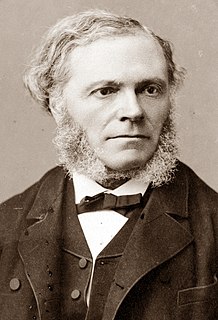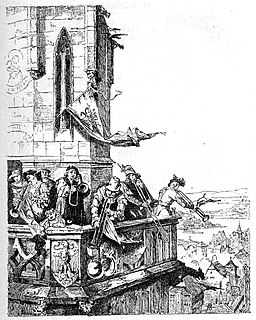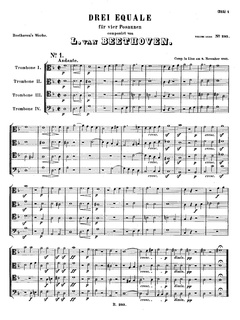
The Classical period was an era of classical music between roughly 1750 and 1820.

In music, a fugue is a contrapuntal compositional technique in more than two voices, built on a subject that is introduced at the beginning in imitation and which recurs frequently in the course of the composition. It is not to be confused with a fuguing tune, which is a style of song popularized by and mostly limited to early American music and West Gallery music. A fugue usually has three main sections: an exposition, a development and a final entry that contains the return of the subject in the fugue's tonic key. Some fugues have a recapitulation.

The term sackbut refers to the early forms of the trombone commonly used during the Renaissance and Baroque eras. A sackbut has the characteristic telescopic slide of a trombone, used to vary the length of the tube to change pitch, but is distinct from later trombones by its smaller, more cylindrically-proportioned bore, and its less-flared bell. Unlike the earlier slide trumpet from which it evolved, the sackbut possesses a U-shaped slide with two parallel sliding tubes, rather than just one.

A symphony is an extended musical composition in Western classical music, most often for orchestra. Although the term has had many meanings from its origins in the ancient Greek era, by the late 18th century the word had taken on the meaning common today: a work usually consisting of multiple distinct sections or movements, often four, with the first movement in sonata form. Symphonies are almost always scored for an orchestra consisting of a string section, brass, woodwind, and percussion instruments which altogether number about 30 to 100 musicians. Symphonies are notated in a musical score, which contains all the instrument parts. Orchestral musicians play from parts which contain just the notated music for their own instrument. Some symphonies also contain vocal parts.
In musicology, the opus number is the "work number" that is assigned to a musical composition, or to a set of compositions, to indicate the chronological order of the composer's production. Opus numbers are used to distinguish among compositions with similar titles; the word is abbreviated as "Op." for a single work, or "Opp." when referring to more than one work.

The Wagner tuba is a four-valve brass instrument named after and commissioned by Richard Wagner. It combines technical features of both standard tubas and French horns, though despite its name, the Wagner tuba is more similar to the latter, and usually played by horn players. Wagner commissioned the instrument for his four-part opera cycle Der Ring des Nibelungen, where its purpose was to bridge the acoustical and textural gap between the French horn and trombone.
This is a list of music-related events in 1812.

Ludwig van Beethoven is one of the most influential figures in the history of classical music. Since his lifetime, when he was "universally accepted as the greatest living composer", Beethoven's music has remained among the most performed, discussed and reviewed in the Western world. Scholarly journals are devoted to analysis of his life and work. He has been the subject of numerous biographies and monographs, and his music was the driving force behind the development of Schenkerian analysis. He is widely considered as among the most important composers, and along with Bach and Mozart, his music is the most frequently recorded.

Ignaz Xaver, Ritter von Seyfried was an Austrian musician, conductor and composer. He was born and died in Vienna. According to a statement in his handwritten memoirs he was a pupil of both Wolfgang Amadeus Mozart and Johann Georg Albrechtsberger. He edited Albrechtsberger's complete written works after his death, published by Tobias Haslinger. His own pupils included Franz von Suppé, Heinrich Wilhelm Ernst, Antonio Casimir Cartellieri, Joseph Fischhof and Eduard Marxsen who would later teach Brahms.

The compositions of Ludwig van Beethoven in the key of C minor carry special significance for many listeners. His works in this key have been said to be powerful and emotive, evoking dark and stormy sentiments.

The Symphony in D minor is the best-known orchestral work and the only mature symphony written by the 19th-century composer César Franck. It employs a cyclic form, with important themes recurring in all three movements.

Piano four hands is a type of piano duet involving two players playing the same piano simultaneously. A duet with the players playing separate instruments is generally referred to as a piano duo.

Peter Bassano is an English conductor.

The Old Cathedral, also called the Church of Ignatius or the Jesuit Church is a church in Linz, Austria. It was built between 1669 and 1683 in Baroque style. From 1785 to 1909 it served as cathedral of the Diocese of Linz.

The Two Aequali, WAB 114 & WAB 149, were composed by Anton Bruckner in 1847.

Tower music is a musical performance from the top of a tower. It can also designate the music composed for or played in such a performance.

Franz Xaver Glöggl was an Austrian musician and musical entrepreneur. He was appointed Kapellmeister of the Cathedral of Linz in about 1797. He was an important figure in the cultural life of Linz. He corresponded with Haydn, Mozart and Georg Joseph Vogler, and was a friend of Beethoven.

The Three Equals for four trombones, WoO 30, are three short equals for trombones by Ludwig van Beethoven.
This page lists classical pieces in the trombone repertoire, including solo works, concertenti and chamber music of which trombone plays a significant part.


















